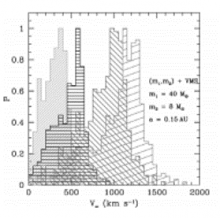
Abstract
We performed numerical simulations of dynamical encounters between hard massive binaries and a very massive star (VMS; formed through runaway mergers of ordinary stars in the dense core of a young massive star cluster), in order to explore the hypothesis that this dynamical process could be responsible for the origin of high-velocity (> 200-400 km/s) early or late B-type stars. We estimated the typical velocities produced in encounters between very tight massive binaries and VMSs (of mass of > 200 Msun) and found that about 3-4 per cent of all encounters produce velocities of > 400 km/s, while in about 2 per cent of encounters the escapers attain velocities exceeding the Milky Ways's escape velocity. We therefore argue that the origin of high-velocity (> 200-400 km/s) runaway stars and at least some so-called hypervelocity stars could be associated with dynamical encounters between the tightest massive binaries and VMSs formed in the cores of star clusters. We also simulated dynamical encounters between tight massive binaries and single ordinary 50-100 Msun stars. We found that from 1 to ~ 4 per cent of these encounters can produce runaway stars with velocities of > 300-400 km/s (typical of the bound population of high-velocity halo B-type stars) and occasionally (in less than 1 per cent of encounters) produce hypervelocity (> 700 km/s) late B-type escapers.